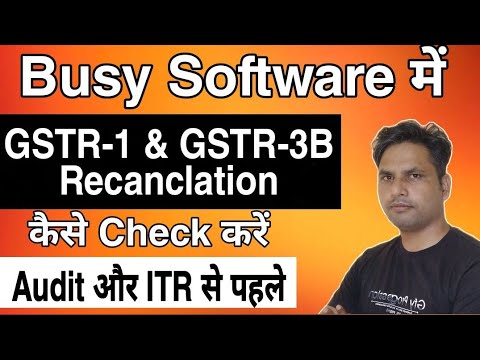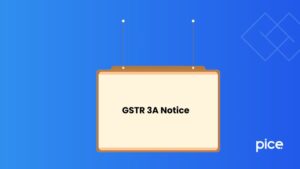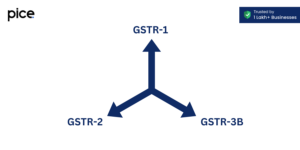How to Reconcile GSTR- 3B and GSTR-1 in India?
- 22 Aug 24
- 15 mins

How to Reconcile GSTR- 3B and GSTR-1 in India?
Key Takeaways
- Ensure Accurate Tax Liability: Regular reconciliation of GSTR-3B and GSTR-1 ensures accurate reporting and payment of tax liabilities.
- Match ITC Claims: Proper reconciliation helps verify that Input Tax Credit (ITC) claims are correct and eligible.
- Identify and Correct Errors: Reconciliation helps detect and correct errors in GST returns, preventing penalties.
- Maintain GST Compliance: Consistent reconciliation ensures compliance with GST laws and smooth return filing.
- Facilitate Data Consistency: GSTR-3B and GSTR-1 should match to ensure consistent and accurate tax reporting.
GSTR-3B is a monthly summary return that taxpayers under the Goods and Services Tax (GST) regime in India must file. It captures a summary of all sales (outward supplies), purchases (inward supplies), and the tax liability of a business for a given month. The primary purpose of GSTR-3B is to provide a quick snapshot of the total taxable value, tax paid, and the input tax credit (ITC) available to the taxpayer.
Key Features of GSTR-3B

- Monthly Filing: All regular taxpayers are required to submit GSTR-3B every month. This ensures that the tax authorities receive timely updates on the business activities and tax obligations of taxpayers.
- Summary of Sales and Purchases: Instead of detailed transaction-level reporting, GSTR-3B requires businesses to provide a consolidated summary of their sales and purchases. This includes the total value of goods and services sold and bought, simplifying the reporting process.
- Facilitates Tax Payment: The return helps businesses calculate their tax liability for the month. It includes the amount of GST to be paid after considering the input tax credit (ITC) available. This ensures that the correct amount of tax is paid on time.
- Mandatory for All Regular Taxpayers: Filing GSTR-3B is compulsory for all regular taxpayers registered under GST. This includes businesses engaged in the supply of goods or services, or both, regardless of their turnover.
- Auto-population of Data: Some of the data in GSTR-3B can be auto-populated from other GST returns, such as GSTR-1, which reduces manual data entry and minimizes errors.
- Adjustment of Advances: Businesses must report any advances received for goods and services in GSTR-3B. These advances are adjusted against future supplies, ensuring accurate tax liability calculation.
- Nil Return Filing: Even if there are no transactions in a particular month, businesses still need to file a nil return. This indicates that there were no sales or purchases during that period, maintaining continuous compliance.
Importance of GSTR-3B
GSTR-3B is crucial for maintaining tax compliance under the GST regime. Accurate and timely filing of this return ensures that businesses:
- Avoid penalties and interest charges for late payment or non-payment of taxes.
- Maintain transparency in their tax reporting.
- Ensure accurate calculation and reporting of their input tax credit (ITC).
- Stay compliant with GST laws and regulations, avoiding legal complications.
What is GSTR-1?
Under the Goods and Services Tax (GST) regime in India, taxpayers are required to submit GSTR-1, which is a comprehensive return. It contains detailed information about all outward supplies of goods and services made by the taxpayer within a specific period.
The return includes invoice-level details of sales transactions, making it crucial for the accurate reconciliation of sales data. The primary purpose of GSTR-1 is to provide the government with detailed records of all sales, helping in the verification and matching of input tax credit (ITC) claims by the buyers.
Key Features of GSTR-1
- Filed Monthly or Quarterly, Depending on Turnover
- Monthly Filing: Businesses with an annual turnover exceeding ₹5 crore must file GSTR-1 on a monthly basis.
- Quarterly Filing: Businesses with an annual turnover up to ₹5 crore have the option to file GSTR-1 quarterly under the Quarterly Return Filing and Monthly Payment of Taxes (QRMP) scheme. This flexibility helps small and medium-sized enterprises manage their compliance requirements more effectively.
- Detailed Information of Outward Supplies
- GSTR-1 requires detailed reporting of all outward supplies made during the reporting period. This includes both inter-state and intra-state sales of goods and services. The return captures the total value of sales, tax liability on sales, and any applicable discounts or adjustments.
- Includes Invoice-Level Details
- One of the critical features of GSTR-1 is the inclusion of invoice-level details. Businesses must report each sales invoice issued during the period, along with the buyer's GSTIN, invoice number, date, taxable value, and applicable GST rates. This granular level of detail ensures that all sales transactions are accurately recorded and helps prevent discrepancies.
- Used for Matching ITC Claims by Buyers
- The GST portal uses the information in GSTR-1 to automatically fill out the buyer's GSTR-2A, which contains information on all purchases. This process helps in the matching and verification of input tax credit (ITC) claims. Accurate reporting in GSTR-1 is essential for buyers to claim their ITC correctly, as any mismatch can lead to discrepancies and delays in ITC claims.
Importance of GSTR-1
Filing GSTR-1 accurately and timely is crucial for several reasons:
- Compliance: Ensures that the business complies with GST regulations, avoiding penalties and legal issues.
- ITC Verification: Facilitates the verification and matching of input tax credit (ITC) claims by buyers, ensuring that they can claim their ITC without any discrepancies.
- Transparency: Provides the government with detailed records of all sales transactions, promoting transparency and accountability in the tax system.
- Error Detection: Helps in the early detection and correction of any errors in sales reporting, minimizing the risk of future audits and penalties.
Comparison of GSTR-3B vs GSTR-1
| Feature | GSTR-3B | GSTR-1 |
| Purpose | Summary return for reporting sales, purchases, and tax liability | Detailed return with invoice-level details of outward supplies |
| Filing Frequency | Monthly | Monthly or quarterly, depending on turnover |
| Details Required | Summary of sales and purchases | Detailed information of outward supplies including invoice details |
| Usage | Facilitates tax payment and summary reporting | Used for matching ITC claims by buyers and detailed reporting |
| Level of Detail | Summary-level information | Invoice-level details required |
| Mandatory For | All regular taxpayers | All regular taxpayers |
| Auto-Population | Some data can be auto-populated from GSTR-1 | Data used to auto-populate buyer's GSTR-2A |
| Reconciliation | Requires reconciliation with GSTR-1 for accuracy | Helps in the reconciliation of sales data |
| Impact on ITC | ITC claimed is compared with details in GSTR-2A | Provides data for ITC claims verification |
| Adjustments Allowed | Adjustments can be made in subsequent returns | Adjustments reported in subsequent returns |
| Penalties for Non-Compliance | Penalties for late filing and incorrect reporting | Penalties for late filing and incorrect reporting |
| Impact of Errors | Errors can lead to interest and penalties | Errors can lead to mismatches in ITC claims |
| Amendments | Cannot be amended once filed | Amendments can be made in subsequent returns |
| Technical Issues | System errors may cause discrepancies | System errors may cause discrepancies |
| Advance Reporting | Advances received must be reported | Not specifically required for advances |
| Nil Return Filing | Required if there are no transactions | Required if there are no transactions |
Reasons for Mismatches in GSTR-3B vs GSTR-1

why mismatches occur between GSTR-3B and GSTR-1 is crucial for businesses to maintain accurate GST compliance. Here are some detailed explanations for the common reasons behind these discrepancies:
Timing Differences
- Timing differences arise when transactions are recorded in different periods in GSTR-3B and GSTR-1. For example, a sale made at the end of one month might be included in GSTR-3B for that month but reported in GSTR-1 for the next month.
- This can happen due to delays in issuing invoices or recording transactions. Such timing differences can lead to temporary mismatches, which need to be identified and rectified in subsequent returns to ensure both forms align correctly.
Incorrect Reporting
- Common data entry mistakes, such as incorrect invoice numbers, GSTINs (Goods and Services Tax Identification Numbers), or tax amounts, can lead to mismatches between GSTR-3B and GSTR-1.
- These errors are often due to manual data entry, lack of proper verification processes, or miscommunication within the organization.
To minimize these errors, businesses should implement stringent data verification procedures and use automated tools for data entry wherever possible.
Non-Filing or Delayed Filing
If a taxpayer fails to file either GSTR-3B or GSTR-1 on time, discrepancies can arise between the two forms. Non-filing or delayed filing can result in one form reflecting the transactions while the other does not, leading to mismatches.
To avoid this, businesses should adhere to the filing deadlines and maintain a robust compliance calendar to ensure timely submission of both returns.
Reversal or Modification of Transactions
Any reversal or modification of transactions after filing can cause mismatches between GSTR-3B and GSTR-1. For instance, if an invoice is canceled or modified after the original filing, it needs to be accurately reflected in subsequent returns.
Keeping track of such changes and ensuring they are correctly reported in both forms is essential to avoid discrepancies.
Input Tax Credit (ITC) Discrepancies
Differences in the Input Tax Credit (ITC) claimed in GSTR-3B and reported in GSTR-1 can lead to mismatches. For example, if a business claims ITC in GSTR-3B but the corresponding supplier invoices are not reported in GSTR-1, it results in a discrepancy.
Accurate reporting of ITC and regular reconciliation of purchase data with supplier invoices are crucial to avoid such issues. Ensuring that all supplier invoices are received and recorded correctly before claiming ITC can help mitigate these discrepancies.
Technical Issues
System errors or technical glitches during the filing process can also result in mismatches between GSTR-3B and GSTR-1. These issues can include problems with the GST portal, network connectivity issues, or software errors.
Regular monitoring of the filing process, timely rectification of technical issues, and maintaining backup copies of all submitted returns can help in identifying and resolving such discrepancies.
Why is it Necessary to Reconcile GSTR-3B and GSTR-1?
Reconciling GSTR-3B and GSTR-1 is a crucial task for businesses under the Goods and Services Tax (GST) regime. Here’s a detailed explanation of why this reconciliation is necessary, incorporating relevant keywords for better understanding and SEO optimization:
- Ensuring Accuracy of Tax Liability
Reconciliation between GSTR-3B and GSTR-1 ensures that the tax liability reported and paid is accurate. Discrepancies between these two returns can lead to either underpayment or overpayment of taxes. Underpayment results in interest and penalties, while overpayment affects the business's cash flow management. Accurate tax liability reporting is essential to maintain compliance with GST regulations and avoid financial implications.
- ITC Reconciliation
Proper reconciliation helps in matching the Input Tax Credit (ITC) claimed with the details provided by suppliers in their GSTR-1. Accurate ITC reconciliation ensures that only eligible ITC is claimed, preventing discrepancies that could lead to ITC mismatches and disallowance by tax authorities.
This process is critical for optimizing the tax benefits and maintaining proper cash flow within the business.
- Error Identification and Correction
Reconciliation helps in identifying and correcting errors in the returns. Common errors include incorrect invoice numbers, mismatched tax amounts, or incorrect GSTINs. Identifying these errors early allows businesses to correct them in subsequent returns, reducing the chances of receiving notices or penalties from tax authorities.
Regular error identification and correction ensure that returns are accurate and compliant with GST regulations.
- Compliance with GST Law
Regular reconciliation ensures compliance with GST laws. The GST regulations mandate consistency and accuracy in the data reported across different returns. By reconciling GSTR-3B and GSTR-1, businesses can ensure compliance with these regulations, avoiding legal issues and ensuring smooth operations. Compliance with GST law also builds credibility and trust with tax authorities, reducing the likelihood of audits and investigations.
- Smooth GST Return Filing Process
Accurate reconciliation makes the GST return filing process smoother. Regular reconciliation helps maintain good records, ensuring that all transactions are accurately reported. This practice avoids last-minute rushes and errors during the filing process.
Additionally, well-maintained records make it easier to respond to queries or audits from tax authorities, ensuring a hassle-free compliance experience.
How to Reconcile GSTR-3B and GSTR-1 in Excel Format

Reconciling GSTR-3B and GSTR-1 is essential for maintaining accuracy in GST compliance. Using Excel for reconciliation can streamline the process, ensuring that discrepancies are identified and corrected efficiently. Here’s a step-by-step guide on how to reconcile these returns in Excel format, incorporating relevant keywords for better understanding and SEO optimization.
Step-by-Step Guide to Reconcile GSTR-3B and GSTR-1 in Excel
1. Prepare the Excel Workbook
- Create Sheets: Set up separate sheets in an Excel workbook for GSTR-3B data, GSTR-1 data, and the reconciliation summary.
- Import Data: Download the GSTR-3B and GSTR-1 data files from the GST portal and import them into their respective sheets.
2. Organize Data for Filing Periods
- Sort by Period: Ensure that the data for each tax period is sorted correctly to avoid timing differences. This helps in matching transactions reported in different periods.
- Check for Accurate Reporting: Verify that the sales details in GSTR-3B match with the invoice-wise details in GSTR-1 for the same period.
3. Match Transaction Details
- Invoice-Level Matching: Use Excel functions like VLOOKUP or INDEX-MATCH to compare invoice numbers, GSTINs, taxable values, and tax amounts between GSTR-3B and GSTR-1.
- Identify Time Differences: Highlight any transactions where there are timing differences, such as sales recorded in different periods in GSTR-3B and GSTR-1.
4. Reconcile Input Tax Credit (ITC)
- ITC Matching: Compare the ITC claimed in GSTR-3B with the details provided by suppliers in their GSTR-1. Ensure that only eligible ITC is claimed and discrepancies are highlighted.
- Manual Intervention: Check for manual errors in ITC claims and rectify them promptly to ensure accurate declaration and filing.
5. Identify and Correct Errors
- Common Errors: Look for common mismatches such as incorrect GSTINs, invoice numbers, and tax amounts. Correct these errors in subsequent returns.
- Legal Consequences: Understand the legal implications of errors and ensure that corrections are made to avoid penalties and interest.
6. Use of Accounting Software
- Automated Tools: Leverage accounting software or ERP solutions that support GST reconciliation. These tools can automate the matching process and reduce manual intervention, ensuring accuracy in reporting.
7. Review Reverse Charge Mechanism
- Reverse Charge Entries: Ensure that transactions subject to the reverse charge mechanism are correctly reported in both GSTR-3B and GSTR-1. Any discrepancies should be identified and corrected.
8. Generate Reconciliation Summary
- Summary Report: Create a summary sheet that consolidates the discrepancies identified during reconciliation. This sheet should include details of mismatched invoices, ITC discrepancies, and any other variances.
- Actions on Reconciliation: Document the actions taken to resolve the discrepancies and update the summary sheet accordingly.
9. Regular Review and Updates
- Continuous Monitoring: Regularly review and update the reconciliation file to ensure that all discrepancies are resolved in a timely manner.
- Annual Return Form: Use the reconciled data to prepare the annual return form, ensuring consistency and accuracy in reporting.
Conclusion
Understanding the differences and importance of GSTR-3B and GSTR-1 is crucial for ensuring compliance with GST laws and smooth business operations. Regular reconciliation helps in maintaining accuracy, avoiding penalties, and ensuring that the business remains compliant with tax regulations. By following a structured approach to reconciliation, businesses can streamline their GST return filing process and avoid common pitfalls.
💡Learn more about how our Pice can help you make all your important business payments, like supplier and vendor payments, rent, GST, & utility, from one single dashboard with your credit card. Request a demo now.




















